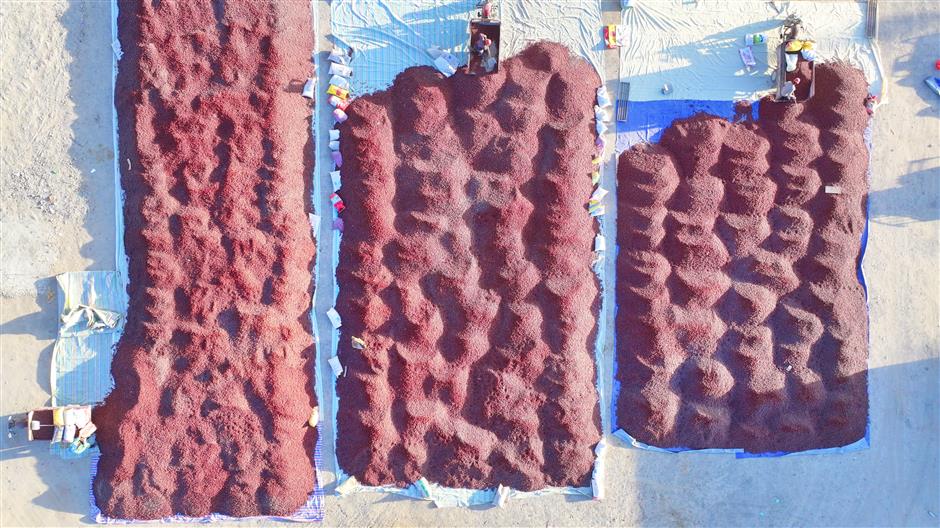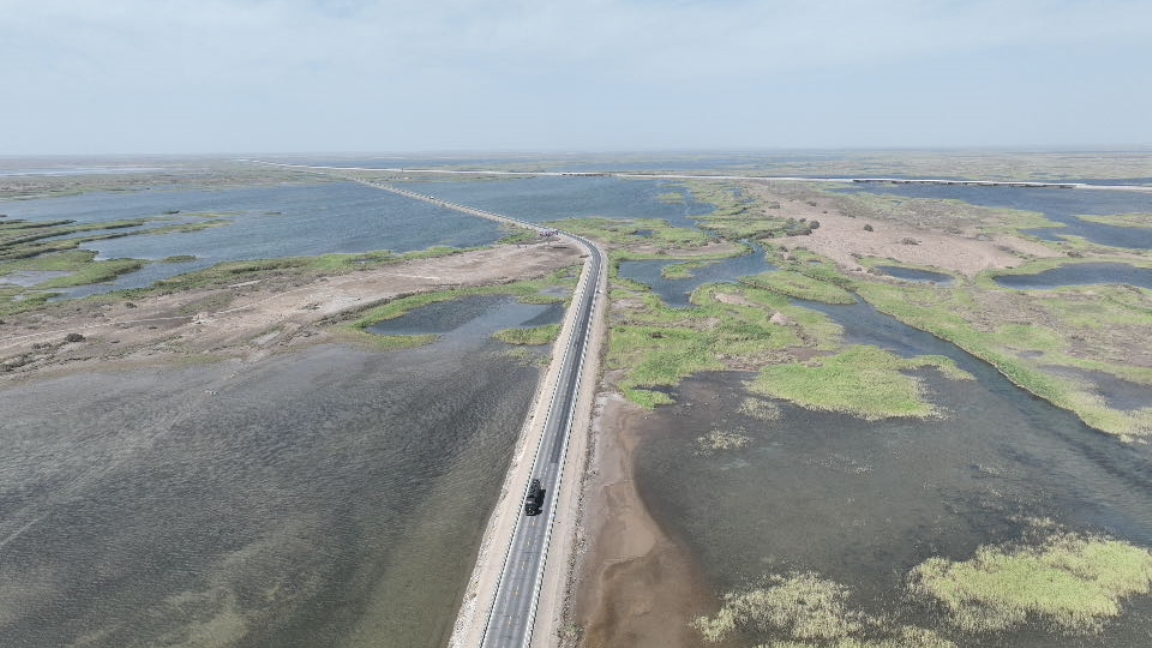
Growth Goes Green
China's economic miracle was once viewed as a calamity for the environment, but the nation has achieved what was once thought impossible: achieving growth while protecting the natural world. This series explores how the world's second-largest economy is reducing its carbon footprint even as its economy powers ahead.
Shot by Yu Wenhao. Edited by Lu Zhixiao. Reported by Zhu Shenshen. Subtitles by Zhu Shenshen.

Relics of Loulan, a legendary city on the ancient Silk Road, lie in the desert now.
Loulan, a legendary city and trading hub on the ancient Silk Road, vanished a millennium ago, swallowed by the shifting sands of the Taklamakan Desert in northwestern China.
Its fate stands as a stark reminder of humanity's enduring struggle against nature in the Xinjiang Uygur Autonomous Region, home to China's largest desert.
Today, however, the tide is turning. Modern technology has entered the battlefield, empowering locals to combat desertification and plant cash crops. Solar power panels, drones and unmanned irrigation systems using artificial intelligence are crucial in building a formidable 3,000-kilometer greenbelt encircling the desert.
This effort aligns with national strategies to address climate change and build a "Great Green Wall," with shelter belts of vegetation to beat back encroaching desert. The aim is sustainable development.
"I have spent my entire life working on desertification control," said Ai Li, a 53-year-old employee with the Yuli County forestry bureau, as he stands at the edge of the Taklamakan Desert in Xinjiang. "The zone appears to be just 10 centimeters on a map, but it is actually 20 kilometers in reality and 30 years of my youth."

Ai Li, a 53-year-old employee with the Yuli County forestry bureau

Huyang, or populus euphratica, lies in the edge of desert in Yuli. The plant is said to live for several thousand years.
Some 56 percent of land in the county is desert. Simple maps track changes in the desert's edges on a wall with large "Battle Against Desertification" slogans and checkerboard-sized "straw lines" mark ongoing victories.
For 33 years, Ai Li has endured the hour-long drives from downtown Yuli to the desert control zone, where his team patrols, plants vegetation and maintains the straw lines.
The region is now transitioning into the next phase, called Biology Desert Control. This involves planting drought-resistant species like jujube and a local plant Luobuma that can be used to make tea, honey, traditional Chinese medicine and clothing fabric.
Yuli is poised to become one of China's biggest producers of tea made from Luobuma, sounds like robusta in Chinese, with 106,666 hectares under plantation.
This phase requires one significant challenge – irrigation.
"Every drop of water is as precious as life itself," Ai Li stressed.
AI technology is now a vital ally in that challenge. It offers smart water and fertilizer management, and systems that can be precisely controlled via a smartphone.

A river, on the road from Yuli to Ruoqiang, has increased spaces with green plants and birds. It used to be around deserts.
A system developed by Guangzhou-based XAG delivers water and nutrients directly to plant roots through pipes, optimizing crop nutrition by controlling timing and volume. The system is very attractive cost-wise, compared with imported products, which makes wide-scale deployment viable in less economically developed regions of China.
XAG, initially known for industrial drones, is now expanding into smart farming systems in recognition of what it calls "human survival and sustainable development."
Four hours' drive from Yuli lies Ruoqiang, China's largest county, which sprawls over an area greater than Shanghai and Zhejiang and Jiangsu provinces combined. It, too, is grappling with severe desertification.
"It only rains one or two days a year, and each time only for a few minutes," a desert control officer there said.

Smart devices, for temperature detection and pest control, stand among jujube plants in Ruoqiang.

Harvest of jujube in Ruoqiang
Smart engineering and biological technologies are also being deployed there. The desert control team is currently planting black goji berries, which yield up to 3,000 kilograms per hectare, with a price of around 30 yuan (US$4.2) per kilogram.
Since 2021, farmers in Ruoqiang have begun cultivating jujube, an economic crop that has made the county one of the biggest jujube producers in the country. Multi-purpose smart devices are also deployed, including smart insect traps that use ultraviolet lights to catch pests, pipes that monitor soil moisture and mobile apps providing real-time weather data.
Maglik, a Uygur jujube farmer in Ruoqiang, currently cultivates 10 hectares of land. Since 2022, harvests have increased his annual income up to 300,000 yuan. Over 80 percent of families in his village now rely on the cash crop for their livelihoods.

Solar panels are built in deserts in Xinjiang.
Solar power plays a vital role in greening desert areas. Large solar panels not only generate electricity but also reduce ground wind speed and erosion, stabilizing the sand. Beneath these panels, drought-resistant plants can thrive, with their root systems further securing the sand.
Ruoqiang has become a major solar-power hub in Xinjiang. In 2024, the county broke ground on a massive power transmission project. The initiative is expected to transmit at least 36 billion kilowatt-hours of electricity annually, with clean energy accounting for more than half.
During construction and operation, the project is expected to create nearly 30,000 jobs, improving local living conditions and fostering high-quality regional economic development.
Beyond just reclaiming desert, technology is now transforming what was once considered China's Wild West into golden business opportunities that even target international markets.

XAG engineer Ai Haipeng is controlling a drone.
In Yuli County, Ai Haipeng, an XAG engineer, and his team are establishing a smart farm pilot project for 200 hectares of cotton cultivation. The farm uses drones, sensors and a suite of Internet of Things devices to control irrigation, fertilization and pest control to achieve cost reduction, stable production and annual profit exceeding a million yuan. The smart systems can be managed by a single individual.
Precise digital management has led to a 15 percent reduction in water use, 24 percent less application of fertilizers and 30 percent lower pesticide use.
"This new farming method has improved quality and established uniform standards for Xinjiang-made cotton, making it more internationally competitive," Ai explained.
In the county of Heshuo, young entrepreneur Tian Miao is cultivating grapes using smart farming techniques. His setup includes a DJI industrial drone for field temperature monitoring, an XAG irrigation system and a Zoomlion water truck. Tian said he aims to sell Xinjiang grapes worldwide, with half of his harvest slated for export next year.
"Traditionally, agriculture relied on visual, tactile experience," he said. "Now data and instruments serve as our eyes and are the basis of smart farming."

A redesigned Zoomlion water truck works in a grape plant garden in Heshuo of Xinjiang.

